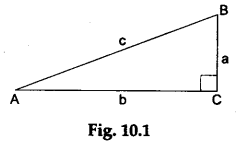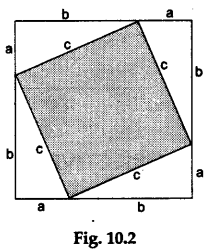Math Labs with Activity – Pythagoras theorem (Method 2)
OBJECTIVE
To verify Pythagoras’ theorem (Method 2)
Materials Required
- A piece of cardboard
- Two sheets of white paper
- A pair of scissors
- A geometry box
- A tube of glue
Theory
Pythagoras’ theorem: In a right-angled triangle, the square of the hypotenuse is equal to the sum of the squares of the other two sides.
Procedure
Step 1: Paste a sheet of white paper on the cardboard.
” On this paper, draw a right-angled triangle ABC, right angled at C. Let the lengths of the sides AB, BC and CA be c, a and b units respectively (see Figure 10.1).

Step 2: Make four exact copies of the right-angled ΔABC on the other sheet of paper. Also, construct a square with each side measuring c units.
Step 3: Cut these four triangles and the square, arid arrange them as shown in Figure 10.2.

Observations and Calculations
We observe that by the combination of the square and the four triangles, a new square is formed which clearly has each side equal to (a+b) units. Then,
area of the large square formed = area of the square with side c + 4 (area of ΔABC)
i.e., (a+b)² =c² +4 (½ x a x b) [∴ area of ΔABC = ½ (a x b)]
=> (a² + b² + 2ab) =c² + 2ab
=> a² + b² =c².
So, the square of the hypotenuse of right-angled ΔABC is equal to the sum of the squares of the other two sides.
Result
Pythagoras’ theorem is verified.
Remarks:
This method is just a process of verification of Pythagoras’ theorem and cannot be used as a proof for the theorem.
Math Labs with ActivityMath LabsScience Practical SkillsScience Labs
